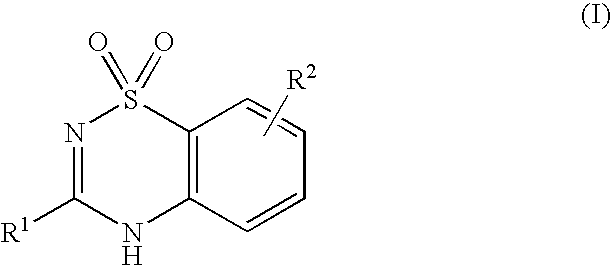Novel Inhibitors of Hepatitis C Virus Replication
- Summary
- Abstract
- Description
- Claims
- Application Information
AI Technical Summary
Benefits of technology
Problems solved by technology
Method used
Image
Examples
example 1
[0420]
[0421]Compound 2, prepared from benzyl bromide and sodium cyanide, was alkylated with 3-methylbutyl iodide to give compound 3. Compound 3 was hydrolyzed to the acid 4, which was converted to the acyl chloride 5. Condensation of compound 5 with diethyl malonate gave compound 6, which cyclized in the presence of methanesulfonic acid to give compound 7. Compound 9 was obtained by methylation of compound 7 with trimethylsilyldiazomethane and subsequent hydrolysis.
Preparation of alpha-(3-methylbutyl)-alpha-phenylacetonitrile (3)
[0422]A mixture of compound 1 (17.1 g, 0.1 mol) and NaCN (5.39 g, 0.11 mol) in 50 mL of ethanol and 300 mL of water was heated (oil bath 98-100° C.) for 5 h. The mixture was cooled, concentrated to remove ethanol, and extracted with ethyl acetate. The organic phase was washed with brine, dried (Na2SO4) and concentrated. Distillation gave 9.25 g of compound 2.
[0423]Compound 2 (9.25 g, 79.06 mmol) was added to a stirred suspension of 60% NaH / mineral oil (3.48 ...
example 2
[0430]
[0431]The acyl chloride 10, obtained by reacting Compound 9 with thionyl chloride, was condensed with 6-amino-3-(methanesulfonamido)benzenesulfonamide 11 to give the coupling product compound 12, which was converted to compound 13 by cyclization under vigorous heating condition. Removal of methyl group was effected by treatment of compound 13 with boron tribromide to yield compounds 101, 102 and 103.
Preparation of 1,3-dimethoxy-2-(1,1-dioxo-6-(methanesulfonamido)-2H-(1,2,4)-benzothiadiazin-3-yl)-4-(3-methylbutyl)naphthalene (13)
[0432]A solution of compound 9 (604 mg, 2.0 mmol) and thionyl chloride (0.4 mL in 1,2-dichloromethane (4 mL) was heated at 60° C. overnight, concentrated to dryness, and under high vacuum. The crude compound 10 in anhydrous dimethoxyethane (3 mL) was added to a solution of compound 11 (531 mg, 2 mmol) and pyridine (0.96 mL, 12 mmol) in anhydrous 1,2-diemthoxyethane (20 mL). The mixture was stirred at room temperature overnight and then triethylamine (1 ...
example 3
[0435]
[0436]Compound 104 was obtained by heating 19 at 200° C., which was prepared by condensation of 10 with 2-aminobenzenesulfonamide (17) in the presence of DMAP and TEA.
Preparation of 1,3-dihydroxy-2-(1,1-dioxo-2H-(1,2,4)-benzothiadiazin-3-yl)-4-(3-methylbutyl)naphthalene (104)
[0437]A solution of 9 (crude, 9.3 mmol) and thionyl chloride (1.7 mL in 1,2-dichloromethane (15 mL) was heated at 50° C. overnight, concentrated to dryness, and under high vacuum. To a solution of the crude 10 in anhydrous DMF (8 mL) was added a solution of 17 (1.60 g mg, 9.3 mmol), DMAP (227 mg, 1.86 mmol) and TEA (2.6 mL, 18.6 mmol) in anhydrous DMF (8 mL). The resulting mixture was stirred at 30° C. for 30 h, diluted with ethyl acetate, washed with brine, dried (Na2SO4) and concentrated. Chromatography on a silica gel with 2-8% EtOAc in DCM gave 1.56 g of 18 as white solid.
[0438]Compound 18 (neat, 1.52 g) was heated under argon at 200° C. for 90 min. The resulting residue was cooled and purified by chro...
PUM
| Property | Measurement | Unit |
|---|---|---|
| Time | aaaaa | aaaaa |
| Time | aaaaa | aaaaa |
| Time | aaaaa | aaaaa |
Abstract
Description
Claims
Application Information
 Login to View More
Login to View More - R&D
- Intellectual Property
- Life Sciences
- Materials
- Tech Scout
- Unparalleled Data Quality
- Higher Quality Content
- 60% Fewer Hallucinations
Browse by: Latest US Patents, China's latest patents, Technical Efficacy Thesaurus, Application Domain, Technology Topic, Popular Technical Reports.
© 2025 PatSnap. All rights reserved.Legal|Privacy policy|Modern Slavery Act Transparency Statement|Sitemap|About US| Contact US: help@patsnap.com



